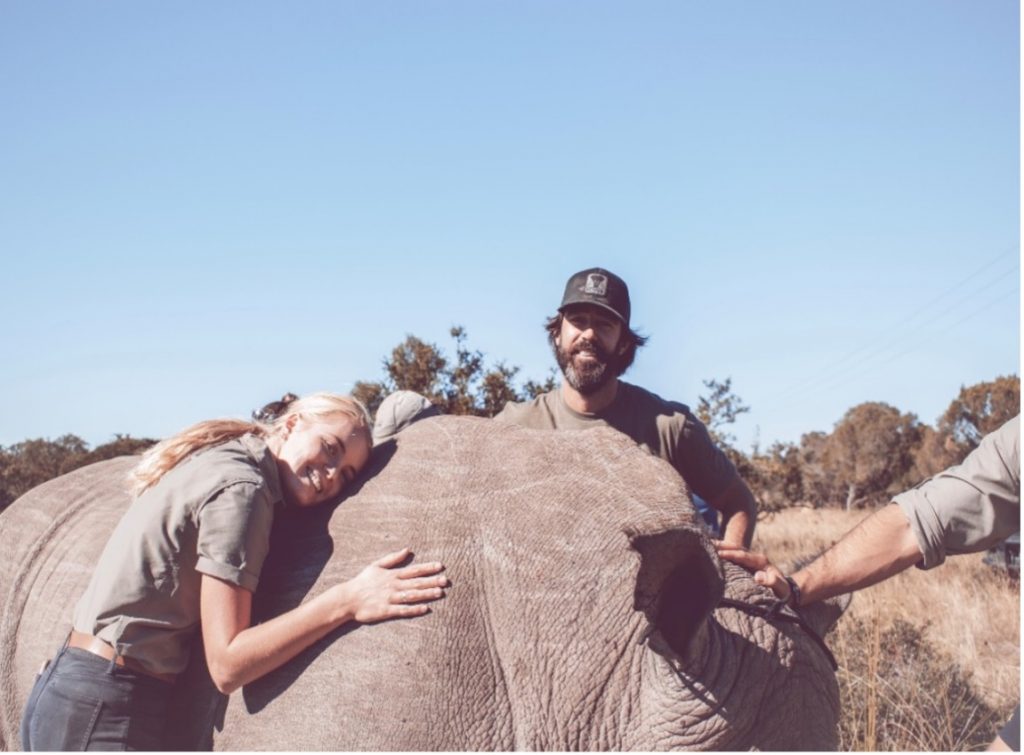
Rhinos and tattoos – a perfect match
The Ink Link is an ongoing project at CN&CO that showcases the diversity of tattoos. One of the great things about a tattoo is that it goes against the commonly-held viewpoint that “what you see is what you get”. There’s a misguided belief in certain quarters that only “some” people get a tattoo. We are putting pay to that perception through the stories showcased in the Ink Link. In this edition, our guest contributor Alex Heath catches up with Hannah Rippon from Buffalo Kloof.

This blog is about the magnificent Buffalo Kloof farm and features Hannah Rippon who is the daughter of Warne Rippon, the owner of the farm. Hannah has grown up and worked in this beautiful space and has a passion for wildlife, the outdoors, and especially the protection of animal species in South Africa. This won’t just be a blog about conservation, but also Hannah’s life and the meaning and story behind one of her tattoos. To start off with, a little about Buffalo Kloof and how it all started.
Buffalo Kloof
Buffalo Kloof is a 20,000-hectare conservancy in South Africa’s beautiful Eastern Cape. It is family-owned and home to Buffalo, Elephant, White & Black Rhino, Cheetah, and numerous other plains game species.

White Rhino cow and calf grazing at Buffalo Kloof – Seeing Rhino calves beside their mothers these days are a true symbol of hope for the iconic species.
In 1999 Warne Rippon had the vision to expand and rewild the Kowie River Valley into a large conservancy. An idea to expand individually owned farmlands and areas of pristine, untouched thicket into a large area with free-ranging animals. The dream was for it to become a Big Five destination for ecotourism or ethical harvesting. From there, the conservancy was born, and hundreds of kilometres of old sneezewood fencing were removed to create a wildlife conservancy. It has been a long road, and they are working to create a balanced ecosystem where wildlife thrives. Guests can enjoy an experience in nature that is uniquely different from any other.

Warne Rippon, Hannah’s dad with Black Rhino during a darting procedure fitting a telemetry tracking device to a rhino that needed to be monitored for health reasons.
Over the years, Warne realised the importance of conserving wild spaces and the significance of rewilding, his once side hobby consumed him and his family as they fell in love with The Kowie River Valley and the idea of making a difference. Warne hopes that through establishing Buffalo Kloof, it will inspire others on the importance of protecting our natural world.

Black Rhino bull quenching his thirst after a hot summer’s day at Buffalo Kloof.
Buffalo Kloof has only been open to the public since 2019, which means they are a relatively new operation. This is because it took a lot of time and effort to get the conservancy ready to showcase to the world and they are not done yet. There is still a lot to do, there is still always room for growth, and there is a long-term vision of expanding Buffalo Kloof, allowing them to protect more habitat so they can create a more significant area for more black rhino to be conserved. The Buffalo Kloof thicket provides an incredible home for black rhino. It’s dense and impenetrable, which means they are tough to find, ideal for their protection and security. At Buffalo Kloof, protecting habitat comes first because you must first ultimately protect habitat if you want to conserve wildlife.
Buffalo Kloof has been actively involved in rhino conservation since 2010, and they remain highly committed to protecting this species. The Eastern Cape province is one of the most critical provinces globally for conserving rhinos, specifically black rhino and black rhino habitats.
About Hannah’s Iife
From a young age, Hannah has known that nature and the outdoors has always intrigued her. Any spare time she had; it would be spent outside. Being born into a family with a passion for wildlife and conservation, Hannah’s love for the outdoors and, more specifically, South African wildlife came naturally. Working alongside wildlife consumes you and everyone who works in the industry will tell you it’s a feeling you cannot describe. It draws you in, and for Hannah, it feels like it sets her soul on fire. It’s a passion and not just a job, and Hannah is so fortunate to be able to pursue her passion every single day.
Rhino have always had a huge special place in Hannah’s heart. She has spent a lot of time working & living alongside this magnificent species since 2010, witnessing their important role in the ecosystem, and their prehistoric appearance mesmerises Hannah every day.

Hannah with white rhino during an ear notching procedure. When rhino calves reach weaning age it is vital to notch their ears. Providing rangers with an effective way of identifying each individual. This is Imperative for rhino security.
The relentless poaching of rhinos continues to escalate across the African continent. A staggering 259 rhinos’ have been lost to poaching in the first 6 months of 2022, with a large portion of them being poached in KwaZulu-Natal. This figure represents only the ones that have been found or reported; the numbers could well be more. The continued battle continues against highly organised crime syndicates. 10 000 of these magnificent animals have been lost to poaching in the last 10 years! rhinos are under tremendous pressure, and if we don’t fight for them, they are inevitably doomed to disappear.
People have no idea what these animals must endure to be protected, having to be tranquilised to have their ears notched. Ear notching is vital to rhino security, providing rangers with a fast and straightforward way to identify each rhino from a distance. Sometimes rhinos have to be dehorned, to make them less of a target to poachers. They have to be relocated at times to take them to safer areas, all to counteract poaching pressures.
What Hannah does at Buffalo Kloof
“With Buffalo Kloof being a family-owned and operated conservancy, the operation always involves all hands-on deck. Staff have specific roles, but everyone helps everyone. It’s a great team effort, dynamic, and every day is different working in the wildlife, tourism, and conservation industry”.

Hannah out in the field – photographing white rhino, pursing her photography passion.
Hannah’s day-to-day depends on what is happening on the conservancy at the time. Her set role is managing Buffalo Kloof’s marketing, website, and social media. This involves video production, writing blogs, spending a lot of time behind the camera, and all the things that come with spreading Buffalo Kloof’s conservation message to the world. She has her FGASA field guide qualification, so when guests are on the property, she is also involved in guiding and hospitality.

“Sometimes you just have to put down the camera and enjoy the precious moments.“ – Hannah while watching a white rhino cow and calf going about their normal day.
Hannah loves spending time outdoors and guiding allows her to share her passion for wildlife and conservation with people from around the world. Some days she helps her mom prepare food for guests in the kitchen. On other days she spends time flying with their Anti-poaching rangers doing air patrols.

Action shot of Hannah guiding at Buffalo Kloof.
Hannah’s story about her tattoo

Hannah assisting with the movement of a white rhino bull from Buffalo Kloof to another reserve.
Hannah’s love for rhinos and the protection of this species is immense and inspiring. This is her story behind the reasoning and meaning behind her first tattoo.
“For a long time, I had thoughts about getting a tattoo. But being an indecisive person at times, I never knew exactly what I wanted. So, I didn’t think too long and hard about what I wanted it to be because I knew one day the right thing would just pop into my head, and so it did. I currently have 5 small tattoos, and they all mean something to me, but my first one means the most.
Witnessing a giant move of black rhino run by WWF called the Black Rhino Range Expansion Project, which aims to increase the growth rate and numbers of the critically endangered species. The project moves them from areas with high densities of black rhino to new areas allowing new black rhino populations to be formed. Managing rapid population growth is essential for conserving this critically endangered species.

Hannah with a black rhino bull during a darting procedure. The black rhino was darted due to a very badly injured back leg. 4 months later he has made a remarkable recovery. Rhino will never be darted at Buffalo Kloof unless absolutely necessary – he was in a very vulnerable condition.
Being involved in this four-day operation changed my perspective forever. I had never ever seen a black rhino before, and I remember this day like it was yesterday! We arrived at the scene in the early hours of the morning. One could feel the excitement, pressure, and adrenalin in the air because all knew the risk and mammoth task that was about to get underway. A group of highly passionate professional people all gathered for a week to relocate this critically endangered black rhino to Buffalo Kloof. The sun had just begun to rise, and I heard the rhythmic, thumping sound of the Bell Huey helicopter in the distance, it was too far to see with the eye, but the sound and the scene gave me goosebumps. Slowly as it got closer, the little black dot in the distance on the horizon turned into the image of a helicopter, with the 1st black rhino slung underneath it against the black drop of the rising sun.

First Black Rhino being slung by a Huey Helicopter during the Black Rhino Relocation. Due to the Black Rhino living in places with limited road access – them being air lifted is the safest and most effective way to move them. After being slung, they are moved into crates and then transported on trucks that are accompanied by high security.
From this day on, I knew my first tattoo would be a rhino. There are so many things it means to me, that I struggle to find the words to explain. For me, it represents a species that has impacted my life. They keep me grounded and make me feel like I have a greater purpose. Every time a person sees the tattoo on the back of my arm, it sparks a conversation, and I love that. Because talking about it and spreading the message on just how important rhino conservation is for Africa and the rest of the world is vital. It reminds me that when working together, we can achieve so much. I couldn’t imagine Africa without rhino, and I hope none of us will ever have to.”






